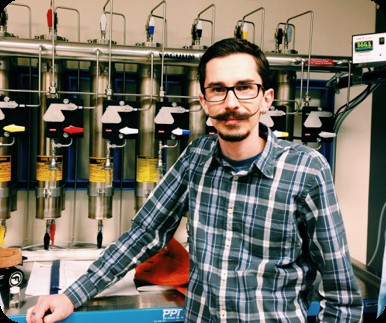News & Events
MSC03 2060
300 Terrace St. NE
Albuquerque, NM 87131-0001
Physical Location:
Clark Hall
Phone: 505-277-6655
chemistry@unm.edu
MSC03 2060
300 Terrace St. NE
Albuquerque, NM 87131-0001
Physical Location:
Clark Hall
Phone: 505-277-6655
chemistry@unm.edu

Profile: Dr. Skye Fortier attended UTEP where he received an NIH MARC (Minority Access to Research Careers) scholarship. As a MARC scholar, Dr. Fortier worked under the direction of Prof. Keith Pannell and was the Vice President of Internal Affairs for the UTEP Chapter of the American Chemical Society-Student Affiliates. He graduated with a B.S. in Chemistry from UTEP in 2005. Dr. Fortier then taught freshmen IPC (Integrated Physics and Chemistry) and junior Chemistry courses at Irvin High School in northeast El Paso. Dr. Fortier entered the graduate program at the University of California, Santa Barbara in 2006. At UCSB, Dr. Fortier worked in Prof. Trevor Hayton’s laboratory. While at UCSB, Dr. Fortier received a number of awards including the Robert H. DeWolfe Graduate Teaching Award and the 2008 Outstanding Chemistry Teaching Assistant Award. Dr. Fortier graduated from UCSB with a Ph.D. in Fall 2011. He was postdoctoral researcher under the joint supervision of Profs. Kenneth Caulton and Daniel Mindiola at Indiana University (IU) and was an NSF American Competitiveness in Chemistry Postdoctoral Research Fellow (ACC-F). Dr. Fortier returned to UTEP Fall 2013 and is currently an Assistant Professor.
Abstract: In this talk, we describe the chemistry of "metastable" iron and titanium complexes supported by N-donor ligands. We have synthesized a "super bulky" guanidinate that is expected to provide kinetic access to reactive metal fragments. To this end, our efforts to synthesize and isolate complexes containing Fe=O/Fe≡N functionalities are discussed. Additionally, we detail our work with titanium supported by guanidinate and imidazolin-2-iminato ligands and describe its reduction chemistry. For example, we have synthesized electron-rich titanium complexes, that when reduced by two-electrons, give highly reducing compounds that exhibit unique reactivity. Using a Ti(II) platform, we observe oxidative-addition of C(sp3)-H bonds which enables catalytic transfer hydrogenation of cyclic olefins. This reactivity and more will be presented.
See Announcement